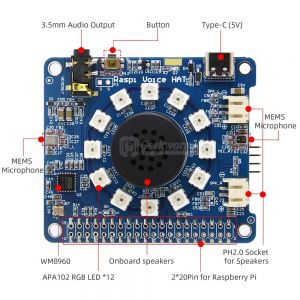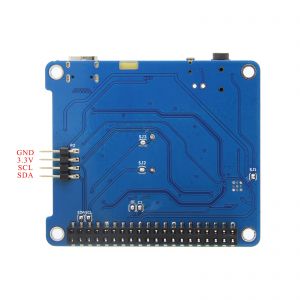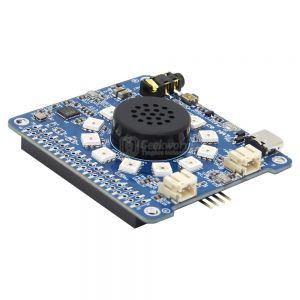Raspi Voice HAT
Overview
Raspi Voice HAT is a Raspberry Pi dual-microphone expansion board specially designed for AI and voice applications. Now you can build a more powerful and flexible voice product that integrates Amazon Amazona voice service, Google Assistant, Baidu AI, etc.
The board is an audio module designed based on the Raspberry Pi. It uses the WM8960 low-power stereo codec, which is controlled by the I2C interface, and the audio is transmitted through the I2S interface. There are two microphones on both sides of the circuit board to collect sound. It also provides 12 APA102 RGB LEDs and an onboard speaker, and provides a user button and an I2C interface for expanding applications.
In addition, the on-board 3.5mm audio jack or JST 2.0 speaker output can be used for audio output, and music can be played through an external headset, and it can also be played with an external speaker through the dual-channel speaker interface. There is a high-quality MEMS silicon microphone on the left and right sides of the board, which can record in stereo.
Features
- Supply voltage: 5V
- Logic voltage: 3.3V
- Audio codec chip: WM8960
- Control interface: I2C
- Audio interface: I2S
- Expansion interface: 1x I2C, 1x button
- Power interface: 1xType-C interface (5V)
- LED interface: 12 APA102 programmable RGB LEDs, connected to SPI interface
- DAC signal-to-noise ratio: 98dB
- ADC signal-to-noise ratio: 94dB
- Headphone driver: 40mW (16Ω@3.3V)
- Speaker driver: 1W per channel (8Ω BTL) (onboard mono speaker)
Packing List
- 1 x Raspberry Pi Voice HAT
Note: Raspberry pi board is not included .
Document
- Voice HAT Software
- Application: http://ukonline2000.com/?p=1251&page=2
Pins and GPIO used
| Pin No. | Usage |
|---|---|
| 2,4 | Power supply |
| 3,5 | GPIO2,GPIO3 for I2C |
| 12,35,40,38 | GPIO18 for I2S |
| 29 | GPIO5 for custom button |
| 31 | GPIO5 for custom button |
How to select GPIO5 or GPIO6 for custom button function? Default is GPIO6;



Enable comment auto-refresher
Anonymous user #4
Permalink |
Lisa
Anonymous user #2
Permalink |
Anonymous user #1
Permalink |
Xiali
Anonymous user #3